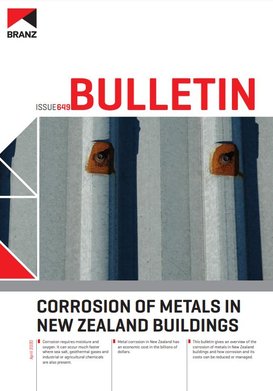
BU649 Corrosion of metals in New Zealand buildings (2020)
Product Description
Corrosion is a chemical or electrochemical reaction between a material and aggressive substances in its surrounding environment. The interaction normally leads to the material being consumed and a reduction of performance, durability and/or visual attractiveness. A common example of corrosion is the rusting of steel, which converts the metal into compounds such as oxides, hydroxides or sulphides.
The economic cost of corrosion is enormous. One New Zealand estimate put it at the equivalent of 2.5% of gross domestic product (GDP) or around NZ$7.5 billion, while another put it at NZ$9 billion. International studies have estimated the annual cost of corrosion as the equivalent of 2-6% of GDP.
This bulletin gives an overview of the corrosion of metals in New Zealand buildings and explains how corrosion can be reduced and managed. BRANZ scientists have researched corrosion for over 40 years, and much of the content in this bulletin reflects their findings.